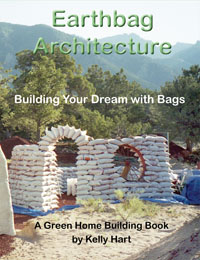EarthbagBuilding.com
Sharing information and promoting earthbag building
| Home | History | Resources | Slide Show |
| About Us | Projects | Plans | Videos |
| Blog | FAQ's | Workshops | Testing |
| Search | Articles | Bulletin Board | Shelter |
| Mass Materials for Earthbag Buildings Questions answered by Kelly Hart |
Q: I am building it right next to the ocean in Nova Scotia and plan to fill the bags with cob. A: Filling the bags with cob in Nova Scotia may not give you enough insulation for the structure to be very thermally efficient. You might consider adding some sort of external insulation, or filling the bags with a more insulating material...which can also affect how high the walls go. For some reason, I thought that cob was very insulating if it was thick enough. Do you recommend a material that we should add or use instead? While it is true that thick walls of thermal mass material will provide some degree of insulation, this is really only advisable in a fairly moderate climate. You might read what Michael G. Smith writes about this aspect of cob. I filled the earthbags for my house high in the mountains of Colorado with a crushed volcanic rock that has a lot of trapped air, and this worked out quite well. Other possibilities include, rice hulls, perlite, and vemiculite...or you could fill the bags with soil and then insulate the outside with a layer of foam insulation. Q: Building in Africa would you advise to built into the ground a bit deeper so that the building is more cool? A: Yes, I believe that in hot climates it is especially beneficial to dig into the ground to take advantage of the relatively cooler temperatures there. You can probably use the earth that you excavate to fill the bags. Q: I haven't decided whether to sink my first dome into the ground a few feet like the Honey House or just build it on grade. In your opinion, are the benefits of the sunken dome worth the effort (or cost) of excavation? I've heard it could make the dome cooler, but I'm also thinking of possible handicapped access at some point (I ain't getting any younger, after all)A: (Owen Geiger) Building below grade is definitely a risk. You never know when a flash flood will pass through. I would only do this in an extremely hot, dry area. And even then, I would want to be on high ground. Instead, I recommend benches and/or earthberming around the perimeter. Q: Do you think that in the tropics where temperatures vary little and earth temperatures are close to air temperatures, that thermal mass in walls is a bad thing for humid areas because moist air will continually condense on slightly cooler wall and floor surfaces? I doubt that the earth underground will feel cooler than the outside air during the coolest part of the night also. Yes, but it is generally during the day that people are active, so that is when it is more important to have cooler temps. I think that buildings below grade should not recommended for hot humid areas unless they are made of gravel bags or sand. I think that all earthbag walls, regardless of what the fill material is, should be protected with a moisture barrier on the outside before they are bermed. Therefore, I see no problem with using adobe fill in the bags that are bermed. I'm pretty sure this is what Owen did with his totally bermed multi-purpose mini-building in tropical Thailand, and I have heard no reports of problems with condensation inside. Owen: No humidity/condensation problems or leaks in the dome any time of year. And there's poor ventilation to boot! And it's totally earth sheltered. During the dry season I water just enough to keep the grass healthy. But it rains like crazy in the rainy season. The ground can get covered with flowing water even though we're on top of a hill! So yes, the dome gets totally soaked for months. Q: My friends keep telling me that I won't be able to live in an earthbag house during our summers as it is not only hot but very humid as well (sometimes 100% humidity) and unlike other deserts, the nights very seldom cool down as well. I told them that I will add wind towers but was told that it won't help unless we have a breeze. I don't think we will have much of a breeze during those 5 very hot months (sometimes up to 50°C - 122°F) can you please give me some advise? I really would like to build with earthbags as I am always sick whenever I am in a concrete building. A: In a climate like the UAE, heat and humidity is obviously the main thing to deal with. I looked on a chart of underground temperatures around the world, and it appears that in that region you can expect underground temperatures to be around 27°C (81°F). all year round. Now that sounds pretty warm, but not unbearable to me...certainly better than anything approaching 50°C. |
See Your Ad |
Disclaimer of Liability and Warranty
We specifically disclaim any warranty, either expressed or implied, concerning the information on these pages. No one associated with this site will have liability for loss, damage, or injury, resulting from the use of any information found on this or any other page at this site.
For Email contact go to About Us
We are interested in communication from others who are exploring the possibilities inherent with earthbag building.
Visit Our Other Websites:
www.greenhomebuilding.com
www.dreamgreenhomes.com
www.naturalbuildingblog.com
